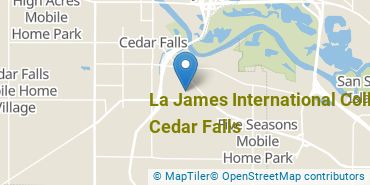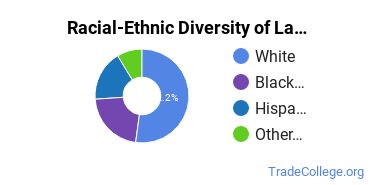La James International College-Cedar Falls Trade Programs
Located in Cedar Falls, Iowa, La James International College-Cedar Falls is a private for-profit institution. The surrounding area of the school is a good match for students who enjoy city life.
Featured schools near , edit
Where Is La James International College-Cedar Falls?

Contact details for La James International College-Cedar Falls are given below.
| Contact Details | |
|---|---|
| Address: | 6322 University Ave, Cedar Falls, IA 50613 |
| Phone: | 319-277-2150 |
| Website: | ljic.edu |
Can I Afford La James International College-Cedar Falls?
Student Loan Debt
It's not uncommon for college students to take out loans to pay for school. In fact, almost 66% of students nationwide depend at least partially on loans. At La James International College-Cedar Falls, approximately 53% of students took out student loans averaging $6,083 a year. That adds up to $24,332 over four years for those students.
La James International College-Cedar Falls Undergraduate Student Diversity
Racial-Ethnic Diversity
The racial-ethnic breakdown of La James International College-Cedar Falls students is as follows.

| Race/Ethnicity | Number of Grads |
|---|---|
| Asian | 0 |
| Black or African American | 4 |
| Hispanic or Latino | 0 |
| White | 14 |
| International Students | 0 |
| Other Races/Ethnicities | 0 |
La James International College-Cedar Falls Trade School Concentrations
The table below shows the number of awards for each concentration.
| Major | Basic Certificate | Undergraduate Certificate | TOTAL |
|---|---|---|---|
| Aesthetician/Esthetician & Skin Care Specialist | 13 | 0 | 13 |
| Massage Therapy/Therapeutic Massage | 0 | 3 | 3 |
| General Cosmetology/Cosmetologist | 0 | 3 | 3 |
| Cosmetology, Barber/Styling, & Nail Instructor | 0 | 0 | 0 |
| Nail Technician/Specialist & Manicurist | 0 | 0 | 0 |
| TOTAL | 13 | 6 | 19 |
References
*The racial-ethnic minorities count is calculated by taking the total number of students and subtracting white students, international students, and students whose race/ethnicity was unknown. This number is then divided by the total number of students at the school to obtain the racial-ethnic minorities percentage.
More about our data sources and methodologies.
Featured Schools
 Request Info
Request Info
|
Southern New Hampshire University You have goals. Southern New Hampshire University can help you get there. Whether you need a bachelor's degree to get into a career or want a master's degree to move up in your current career, SNHU has an online program for you. Find your degree from over 200 online programs. Learn More > |
